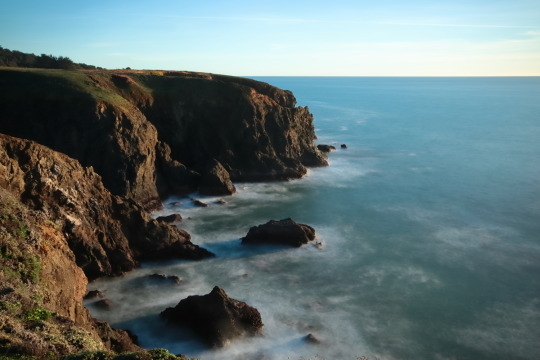#Neutral Density Filters
Explore tagged Tumblr posts
Text






A few of my favorite shots from Feast of the Hunters' Moon this past weekend! I took my Pentax MX and shot one roll of color film and one roll of black & white. As much as I love color generally, I'm really pleased with how the black & white shots came out!
Color film: Kodak UltraMax 400 B/W film: Kodak Double-X Developed & scanned by me
And a bonus: your humble photographer, as captured by @witchertits!

#i got a lot of use out of my bargain bin graduated neutral density filter#it works great but i can't put my lens cap on over it because the size is weird#my photography#analog photography#feast of the hunters' moon#technically the group shot is us at the culver's in lafayette but we were still in garb so it counts
10 notes
·
View notes
Text
Photography Inspirations
Woke up early today to find out that It is 2 degrees celcius in London today and wondered whether I should just stay in bed or brave the cold and go take some pictures before work. I haven’t been out lately because it’s been raining non stop since last week. Even tough I’ve felt a bit unproductive and a bit lazy of late I feel that it is important to keep myself inspired. One thing I noticed is…

View On WordPress
#adobe lightroom#adobe photoshop#architectural photographer#architectural photography#architecture#architecture photography#art#Arts and Entertainment#benefits of photography projects#Black & White#black and white#black and white photography#choosing photography project#city of London#Fine Art#fine art photographer#fine art photography#formatt hitech#formatt hitech neutral density filters#landscape#Landscape photography#London#long ex#long exposure architectural photography#long exposure photography#making a great image#Michael Kenna#national history museum#Neutral density filters#Photograph
5 notes
·
View notes
Text
Precision Absorptive Neutral Density Filters from Sherlan Optics
0 notes
Text
ND Filter Coatings - Accurate Optics

Neutral Density (ND) filter coatings are specialized coatings applied to camera lenses or filters to modify the intensity of light entering the lens without affecting its color. These coatings reduce the overall amount of light passing through the lens, allowing photographers to achieve certain creative effects or control exposure in different lighting conditions. To know more, call us at +91-9888877542 or visit our website.
0 notes
Text
Round 2 - Mollusca - Caudofoveata




(Sources - 1, 2, 3, 4)
Caudofoveata is a small class of shell-less, worm-like molluscs somewhat similar to solenogasters.
Caudofoveatans make up for their lack of shell with a coat of calcareous spines, called sclerites, embedded within their mantle. These sclerites can stick up to form a palisade or can lie flat against the animal. Their head is covered by a hard shield studded with sense cells to help the animal orient itself. Unlike solenogasters, they do not have a foot and live mostly sedentary lifestyles burrowed within soft sediment. Most are filter-feeders, lying vertically on the ocean floor with just the mouthparts exposed and taking in passing organic detritus. Some are more selective detritivores or predators of single-celled organisms. Unlike solenogasters, caudofoveatans have seperate sexes and exhibit external fertilisation, releasing sperm into the water column. The female will brood her fertilized eggs, which will hatch into planktonic trochophoric larvae. They are exclusively marine, living at a depth of more than 20 m, where they can appear in a density of up to 4 to 5 individuals per square metre, as far down as the deep sea.
Caudofoveatans and the similar solenogasters are often considered the most primitive molluscs. Unlike other shell-less molluscs which lost their shells secondarily, caudofoveatans have yet to evolve shells. Along with Polyplacophora and Solenogastres, Caudofoveatans likely originated at least 540 million years ago, at the Ediacaran–Cambrian border.

Propaganda under the cut:
Caudofoveatans are also important to understanding the early evolution of molluscs, and how this phylum came to be.
Chitons’ shell plates are believed to have evolved from calcareous scales similar to those of caudofoveatans’ sclerites.
Most caudofoveatans are very small, ranging 0.02–10 cm in size, but one species, Chaetoderma felderi, can reach 36.5 cm!
Caudofoveatans are the least known, and possibly the least researched class of molluscs. In fact, they weren’t even understood as molluscs until the end of the 19th century. They were once regarded as sea cucumbers, along with solenogasters.
23 notes
·
View notes
Text

Mendocino Coast at Hearn Gulch. Long exposure seascape, North Pacific ocean. 10 stops neutral density filter, Canon SL3, f/9, 20mm, ISO-100, 20s. Post processing using Canon's DPP4.18.10. Cheers!
51 notes
·
View notes
Text
The cheeky last minute UI rework
A week ago, I had Lucinius play a near-complete version of the demo build and he had a bunch of good suggestions after playing it for a solid few hours.
One part of his feedback centered around how move information was displayed. Previously, in non-battle menus, the move info would follow your cursor, and thus you weren't able to mouse over the various stats or check the description (which would have outputted to a log that isn't visible anyway).
Now I've made it so that clicking on the move icon displays the window in a static pane, letting you mouse over the various icons. Also, the description now appears in-line inside the window, regardless of where you're looking at it!
I made a whole bunch of other changes, and ahead of tomorrow's demo release (I can't believe it's finally happening), you can read about them below the cut!!
v0.18 - Demo Build 1
Features:
Auto-deposit materials is working and on by default
Mouse over now shows curr/max for hp/en/ammo + stat title
Going past the max floors now sends you back to the ship
New trap added that instantly spawns an encounter
Clicking on an attack icon with the mouse now makes the info panel stay open
Clicking the description button/pressing pause with a move selected now displays it within the panel
Archive sprite added to base
Game now tracks enemies encountered and killed
Added target marker to tutorial area
Archive can view logs and tutorials, and enemy names
Balance:
Starting area has slightly more loops
Starting area has slightly higher encounter density,
Removed local relay from starting area
Added spatial constant to starting area
Added Holepunch routine to Punch Press
Slightly increased passive random recruit chance from 1 to 2%
Buffed max damage recruitment rate divisor from /3 to /2.5
Nerfed heal recruitment rate divisor from /3 to /4
Changed starting system escape fuel needed to 20
Gain a small amount of fuel when researching local/relativistic navigation
Added party size to the base matrix research rather than subsequent research
Features now scale around the mid floor of the dungeon instead of around floor 2
Dungeon floors, rooms, and corridors get bigger as you go down
Damage/heal recruit function ceiling'd so you make at least 1% progress when you do the correct action
Slightly revised title screen animation
Revised enemy encounter formula to scale around the center floor of the dungeon + adjusted dungeon encounter mass respectively
Changed Gimbal Lock's status from stun to slow
Made summons recruitable
Buffed all part slots and changed power load formula to compensate
10% buff to large enemy stats for each square above 1
Make killing with an element apply advantage, even if it resists or was neutral to the element
Polish:
"are likely in rooms" -> "are more often found in rooms"
"can be used for fuel" -> "could be used for fuel"
"once a line has formed" -> "once a line has formed in the element grid"
"the astronaut has been destroyed" -> "your suit has been critically damaged"
"the robot core's power load." -> "the robot core's power load (to the left of the equipped parts)."
Power load tutorial only comes up when you exceed it
Changed POWR to HEAL when looking at a healing move in the attack description
Disabled interaction with central 3x3 core area and changed description
Changed first strike/ambush bar colour and text
Added fuel unit value to fuel item descriptions
Added filter menu icon
Deep Diver sprite updated
Burrow sprite updated
Recruit chance icon doesn't show mouseover text when invisible
Swapped weapons 1 and 2 equip location on the assistant to match sprite appearance
Removed extra line on the bottom of the big map
Equip vfx effect now appears under move info panel
Black outline added to all dungeon features
Made recruitment pink text appear over the damange numbers
Made it so that locations can't spawn directly behind the black hole image in the navigation screen
Made the main black hole image slightly transparent in the navigation screen
Reordered research tutorials
Scan description revised to indicate it can reveal more and more information progressively
Updated matrix tutorial to talk about core tiers
Changed equip sprite fx to green
Swapped arm that has the arm computer in a cutscene
Tutorial edited to say cores have innate routines
Edited lowest_5levels to be an accurate tutorial
Bugs:
Disabled the ability to look at the big map during the beginning of an encounter
Floor scanning effect now shows all the time for unexplored tiles
Removed debug value allowing you to interact with lore objects infinite times
Priority of mouseover is only cleared with the text now
Fixed player recruit chance status doing the opposite of what it says it does
Fixed healing-type recruitment not working
Fixed no item tutorial firing incorrectly because research inventory manager was not ready
Conduct animation was not happening when the conducted element was not the last hit on an enemy
Fixed lowest floor tutorials not firing
#indiedev#gamedev#gaming#pixel art#scifi#space#gamemaker#programming#rpg#robot#devblog#videogame#codeblr
19 notes
·
View notes
Text
Yvette Heiser - Mastering Filters in Photos for High-Impact Professional Photography
In professional photography, taking the ideal photo is just the beginning of the creative process. The other half lies in how you enhance and present your images to create a lasting impression. Filters play a crucial role in this process, allowing photographers to manipulate light, color, and mood to produce high-impact visuals. Yvette Heiser - The Role of Light in Professional Photography highlights how understanding light and using filters effectively can dramatically transform a photo’s atmosphere and appeal. Mastering filters in photography is essential for anyone aiming to elevate their work from ordinary snapshots to compelling, professional-grade images.

Understanding Filters: More Than Just Effects
Filters are not just trendy overlays or Instagram presets. In professional photography, filters serve as powerful tools that modify how light interacts with the camera sensor or film. Filters generally fall into two categories: physical filters that attach directly to the camera lens and digital filters added during the editing process.
Physical Filters
Physical filters are glass or resin attachments placed on the camera lens. Some common types include:
Polarizing Filters: These reduce reflections and glare from surfaces like water or glass, enhancing color saturation and contrast.
Neutral Density (ND) Filters: ND filters reduce the amount of light entering the lens, enabling longer exposure times or wider apertures even in bright conditions.
Graduated ND Filters: These help balance exposure between bright skies and darker landscapes.
Color Filters: Used primarily in black-and-white photography, these filters can accentuate contrasts or tones.
Digital Filters
Digital filters are applied during editing using software like Adobe Photoshop or Lightroom. They can simulate the effects of physical filters or introduce creative adjustments such as:
Color grading
Sharpening or softening
Adding vignettes or lens flares
Enhancing textures
Why Mastering Filters Is Vital for Professionals
Using filters effectively allows photographers to control their image’s story and emotional impact. Whether aiming for a dramatic landscape or a crisp product shot, filters help set the tone. Here’s why mastering them matters:
Enhance Visual Appeal: Filters can make colors pop, deepen shadows, and add contrast that draws the viewer’s eye.
Control Light: Proper use of ND or polarizing filters helps manage tricky lighting situations, enabling clearer, more balanced photos.
Create Mood and Style: Filters contribute significantly to the mood of an image, whether it's a warm, nostalgic feel or a cold, modern aesthetic.
Save Time in Editing: Skilled use of physical filters can reduce the need for extensive post-processing, saving time without sacrificing quality.
Tips for Mastering Physical Filters
Invest in Quality Gear: High-quality filters maintain image sharpness and avoid unwanted color casts. Cheap filters can degrade your photos.
Understand Your Environment: Know when to use each filter depending on lighting conditions and subject matter.
Practice Long Exposures: Use ND filters to capture motion blur in waterfalls or clouds for artistic effects.
Rotate Polarizers: Adjust the polarizing filter to find the best angle for reducing glare and boosting colors.
Tips for Mastering Digital Filters
Subtlety Is Key: Avoid overusing digital filters that make images look artificial.
Learn Color Theory: Understand how color adjustments affect mood and composition.
Use Layer Masks: Apply filters selectively on different parts of an image for balanced results.
Experiment with Presets: Start with presets to learn different styles, then customize them to fit your vision.
Combining Physical and Digital Filters
The most impactful professional photos often result from a blend of physical and digital filtering techniques. For example, a photographer might use a polarizing filter during shooting to reduce glare and then apply digital color grading to enhance mood in post-production. This combination provides greater control and flexibility than relying on one method alone.
Common Mistakes to Avoid
Overfiltering: Too many filters can clutter an image and distract from the subject.
Ignoring White Balance: Filters can alter color temperature; always adjust white balance accordingly.
Neglecting Lens Quality: Using low-quality lenses with filters can cause unwanted effects like vignetting or softness.
Relying Solely on Digital Filters: While convenient, digital-only approaches sometimes lack the authenticity that physical filters provide.
Conclusion
For photographers aiming to produce striking, professional-quality images, learning how to effectively use filters is an essential skill. Yvette Heiser – Texas, talks about the importance of filters in photos, emphasizing how understanding both physical and digital filters, knowing when and how to use them, and avoiding common pitfalls can significantly improve the visual quality and emotional depth of their work. Whether shooting landscapes, portraits, or commercial projects, filters are indispensable tools that help transform ordinary photos into powerful stories told through light and color. Invest time in learning these techniques—it’s an investment that will pay off in every frame you capture.
#camera#pictures#photographer#wedding#moments#photography#yvette heiser#photographytips#childphotography#events
6 notes
·
View notes
Text




I decided to move the DBAL A2 back a little bit to clear up space for a dedicated flip-up front sight.
Something about the lack of anti-rotation geometry on the Railscales LEAF just rubs me the wrong way :V
Having it back here also gives me more instantaneous access to the controls on the unit itself. Though I'll need to see how much (if any) IR splashback I get from the illuminator before I fully commit to this arrangement.

Some of you may have noticed that my DBAL no longer has its default rubber dust caps and I've since added a neutral density filter to the laser side to cut back on the bloom of the full power laser.

...Now if only OpticsPlanet would hurry up and ship the fuckin Diffuser, I could call this laser setup complete >:V
#dbal a2#steiner optics#laser aiming module#ir laser#multi function aiming laser#urgi#nightfighting rifle#night vision
2 notes
·
View notes
Text
LensCraft Mastery: Elevate Your Photography Skills to the Next Level

Photography is more than just pressing a button; it’s an art, a science, and a means of storytelling. LensCraft Mastery is a comprehensive guide designed to help photographers—whether beginners or seasoned professionals—unlock their full creative potential. This tutorial series delves into the intricate aspects of photography, from mastering the fundamentals of exposure and composition to exploring advanced techniques in lighting, post-processing, and storytelling through imagery.
Why LensCraft Mastery?
The name LensCraft Mastery symbolizes the fusion of technical expertise (Lens) with artistic craftsmanship (Craft). Photography is both a technical discipline and an expressive medium, requiring a balance between understanding camera mechanics and developing an artistic vision. This tutorial series aims to bridge that gap by offering structured, easy-to-follow lessons that cater to all levels of experience.
1. Mastering the Basics of Photography
For those new to photography, LensCraft Mastery begins with the fundamental concepts that form the backbone of great photography:
Exposure Triangle: The Key to Perfectly Lit Photos
Aperture: Understanding how f-stops affect depth of field and light intake.
Shutter Speed: Capturing motion creatively, from freezing action to long exposures.
ISO: Controlling sensor sensitivity for optimal brightness without excessive noise.
Composition Techniques: Crafting Visually Stunning Images
Rule of Thirds: Placing subjects strategically for balanced compositions.
Leading Lines: Drawing the viewer’s eye to the subject.
Framing & Negative Space: Enhancing depth and focus in a photograph.
2. Advanced Photography Techniques
Once the basics are mastered, LensCraft Mastery delves into techniques that can take your photography to a professional level.
Understanding Light & Shadows
The role of natural light vs. artificial lighting in photography.
How to use soft light for flattering portraits and harsh light for dramatic effects.
Mastering golden hour and blue hour photography.
Camera Settings & Manual Mode
How to use manual focus for precision.
Customizing white balance for accurate color reproduction.
Shooting in RAW vs. JPEG and when to use each format.
3. Specialized Photography Genres
Photography is a vast field, and LensCraft Mastery explores different genres, allowing photographers to find their niche.
Portrait Photography
How to pose subjects naturally for candid and professional shots.
Best lenses for portrait photography (prime vs. zoom).
Background blur (bokeh) techniques for dreamy aesthetics.
Landscape Photography
Composition techniques for breathtaking vistas.
Use of ND (neutral density) filters for long exposures.
How to capture the perfect sunrise and sunset.
Street Photography
Capturing the essence of everyday life.
Ethical considerations in photographing strangers.
How to blend into the scene for natural compositions.
Wildlife & Macro Photography
Tips for photographing animals in motion.
Choosing the best gear for close-up macro shots.
Patience and planning for capturing rare moments.
4. The Power of Post-Processing
A great photo doesn’t always end with the camera—post-processing is essential for refining images. LensCraft Mastery provides in-depth tutorials on:
Adobe Lightroom & Photoshop Editing
Adjusting exposure, contrast, and white balance for balanced images.
Retouching techniques for portraits and landscapes.
Removing unwanted elements and enhancing details.
Mobile Editing for On-the-Go Photography
Best apps for editing (Snapseed, VSCO, Lightroom Mobile).
Color grading techniques for a unique aesthetic.
Quick retouching methods for social media-ready images.
5. Developing a Photographer’s Mindset
Photography is more than just technical skill—it requires creativity, patience, and an eye for detail. LensCraft Mastery helps photographers develop a storytelling approach, teaching how to:
Capture emotions and narratives within a single frame.
Use minimalism and abstract photography to create intriguing images.
Experiment with angles and perspectives to bring a fresh outlook to everyday scenes.
6. Monetizing Your Photography Skills
For those looking to turn their passion into a profession, LensCraft Mastery includes insights on:
How to start a photography business and build a portfolio.
Selling photos online (stock photography, prints, NFTs).
Social media strategies to grow an audience and attract clients.
Final Thoughts
Whether you’re just starting or looking to refine your craft, LensCraft Mastery offers a structured, engaging, and practical way to enhance your photography skills. By blending technical knowledge, artistic creativity, and real-world applications, this tutorial series is designed to empower photographers at every stage of their journey.
Start mastering your craft today and turn your vision into reality—one frame at a time. 📸✨
2 notes
·
View notes
Text
What is the Alkaline Diet? A Complete Guide for Beginners

The Alkaline Diet: A Healthy Eating Plan for Optimal Wellness
The alkaline diet has become an increasingly popular way of eating that promotes overall health and wellness. This eating plan focuses on foods that help balance your body's pH levels to create an environment that supports healthy cells and tissues.
What is the Alkaline Diet?
The alkaline diet is based on the principle that the foods you eat can alter your body's pH balance and impact your health. The ultimate goal is to create an internal environment that has a pH ranging from 7.35 to 7.45, which is slightly alkaline. Foods are categorized as either acidic, alkaline, or neutral: Alkaline foods - Fruits, nuts, legumes, and vegetables Acidic foods - Meat, dairy, eggs, grains, alcohol, and processed foods Neutral foods - Natural fats, starches, and sugars By emphasizing alkaline foods and limiting acidic foods, proponents of this diet believe it can help neutralize chronic low-grade acidosis linked to inflammation, fatigue, and increased disease risk.
Benefits of an Alkaline Diet
Following an alkaline diet offers impressive benefits: Promotes pH balance Reduces inflammation Boosts immunity Increases energy Aids weight loss efforts Improves cardiovascular health Strengthens bones Detoxifies the body The diet focuses on nutrient-dense whole foods that provide antioxidants, vitamins, minerals, fiber, and water to help neutralize acids and remove toxins from the body. Balances pH Levels One of the main goals of the alkaline diet is to balance the body's pH levels. Chronic low-grade acidosis happens when acidic wastes accumulate in the body faster than they can be neutralized. This causes the body's pH to drop into unhealthy ranges. The alkaline diet counteracts this acidity and helps: Regulate fluids and electrolytes Filter out toxins and wastes Transport nutrients into cells Together this provides an ideal environment for cells and systems to function properly. Reduces Inflammation Acidosis creates an environment inside the body that promotes inflammation, a key factor in many chronic diseases. The anti-inflammatory foods emphasized on the alkaline diet can help reduce acidity and calm this internal fire. Some examples include: Fruits high in vitamin C Green leafy vegetables Nuts like almonds and walnuts Plant-based proteins like lentils and beans Lower levels of inflammation helps people feel better day-to-day. But even more importantly, it lowers the risk for disorders caused by chronic inflammation. Other Key Benefits Some other top reasons to follow the alkaline diet include: Increased Energy Levels - A balanced pH provides cells with ideal conditions for producing energy. Healthy Weight - The diet emphasizes low energy-density foods that support weight loss. Strong Bones - The diet provides bone-building nutrients often lacking in modern diets. Detoxification - Alkaline foods help remove acidic waste products and toxins. Together this creates an internal terrain that discourages damaged cells and chronic diseases from taking root.
The Best Alkaline Foods to Eat

Focus your diet around these alkaline superfoods: Fruits Fruits are packed with alkaline-promoting nutrients. Choose fresh or frozen organic when possible. Top picks include: Lemons Watermelon Apple Grapefruit Kiwi Berries Papaya Pears Vegetables Aim for eating a variety of organic vegetables each day. Great options include: Spinach Kale Cucumbers Celery Carrots Sweet potatoes Broccoli Sea vegetables Nuts and Seeds Nuts and seeds are excellent sources of protein and healthy fats. Soak nuts before eating to boost nutrients. Try: Almonds Flaxseeds Pumpkin seeds Sunflower seeds Chestnuts Chia seeds Herbs, Spices and Oils Boost flavor and pH with these additions: Lemongrass Ginger Turmeric Cinnamon Garlic Cold-pressed olive oil Coconut oil Avocado oil
Foods to Avoid on the Diet

To balance your pH effectively, you’ll also want to avoid or limit these acidic foods: Red meat Poultry Seafood Eggs Dairy products Processed grains Sugar Packaged snacks Soda Alcohol Coffee Even whole grains and beans - two staples of healthy diets - should be eaten sparingly since they skew acidic.
Additional Tips for Success
Follow these suggestions to make the most of an alkaline diet: Stay well hydrated with alkaline water Enjoy herbal teas Reduce stress through yoga, meditation, etc. Exercise at least 30 minutes daily Add more raw foods slowly Focus on how you feel As with any significant change to your diet, implement this eating pattern gradually. This gives your body time to adjust its complex systems. Pay attention to the signals your body is sending about the changes. Over time, you should feel less internal "discomfort" and more vibrant energy. Chronic issues you learned to tolerate could show improvement or fade away completely.
The Bottom Line
The emerging research shows an alkaline diet may be an extremely healthy way to prevent damage from modern diets and lifestyles. While studies continue, adjusting your eating pattern to favor alkaline foods poses little risk and offers tremendous potential. It provides a sustainable, nutrient-dense approach to eating that fights inflammation and encourages good health starting on the inside! Doctor Sebi Cell Food Diet Explained: Components, Purported Benefits, Controversy & Safety Reviewed Read the full article
13 notes
·
View notes
Text
Is Lactose-Free Cow Milk the Ideal Choice for Lactose-Intolerant Individuals?
Lactose intolerance is a prevalent condition worldwide, affecting millions of people who experience digestive discomfort when consuming regular milk and dairy products. For those individuals, lactose-free cow milk offers a promising alternative. But how beneficial is it? In this blog, we will delve deeply into the topic, exploring what lactose-free cow milk is, its benefits, drawbacks, and its role in managing lactose intolerance.
Understanding Lactose Intolerance: The Basics
What is Lactose?

The Root Cause of Lactose Intolerance
Lactose intolerance occurs due to a deficiency of the enzyme lactase, which is responsible for breaking down lactose into glucose and galactose. When lactose isn’t digested, it passes into the colon, where gut bacteria ferment it. This fermentation leads to symptoms like:
Bloating
Abdominal pain
Gas
Diarrhea
Nausea
Prevalence of Lactose Intolerance
Lactose intolerance affects approximately 68% of the global population. Its prevalence varies widely:
Over 90% in East Asian populations
60��80% in Sub-Saharan African and South Asian populations
15–25% in Northern European populations
The severity of symptoms varies among individuals based on their lactase enzyme levels and the amount of lactose consumed.
What is Lactose-Free Cow Milk?
Lactose-free cow milk is regular a2 desi cow milk that has been specially treated to remove or neutralize lactose. The two main methods used are:
Enzymatic Treatment: Lactase enzyme is added to the milk to break down lactose into glucose and galactose. This process mimics the natural digestion of lactose in the body.
Ultrafiltration: Physical methods are used to filter out lactose molecules from the milk.
Despite these modifications, lactose-free milk retains its nutritional profile, including:
High-quality protein: Essential for muscle growth and repair.
Calcium: Vital for bone health.
Vitamin D: Crucial for calcium absorption and immune support.
B Vitamins: Important for energy metabolism and red blood cell formation.

The Benefits of Lactose-Free Cow Milk
1. Relief from Digestive Discomfort
Lactose-free milk eliminates the primary trigger of symptoms in lactose-intolerant individuals. By removing or breaking down lactose, it allows people to enjoy milk without bloating, cramps, or diarrhea.
2. Nutritional Equivalence
Lactose-free milk provides the same nutrients as regular A2 cow milk, ensuring that individuals meet their dietary requirements for:
Calcium and Vitamin D: Essential for bone density and preventing osteoporosis.
Protein: Important for maintaining overall health, especially for growing children, athletes, and elderly individuals.
3. Improved Taste
Interestingly, many people find lactose-free milk slightly sweeter than regular milk. This is because the enzymatic breakdown of lactose produces glucose and galactose, which are naturally sweeter than lactose.
4. No Major Dietary Changes Required
Switching to lactose-free milk allows lactose-intolerant individuals to maintain a dairy-inclusive diet without the need for drastic changes. It can be used in the same way as regular milk for drinking, cooking, baking, or adding to beverages like tea and coffee.
5. Wider Availability
With the growing awareness of lactose intolerance, lactose-free milk is now widely available in supermarkets, making it an accessible choice for most consumers.
How Does Lactose-Free Milk Differ from Dairy-Free Alternatives?
It’s essential to differentiate between lactose-free and dairy products. While they may seem similar, they cater to different dietary needs:
Lactose-free milk is ideal for those who are lactose-intolerant but still want the nutritional benefits of cow milk, whereas dairy-free milk is suitable for those with both lactose intolerance and dairy allergies or who follow a vegan lifestyle.
Potential Drawbacks of Lactose-Free Milk
While lactose-free cow milk is a great solution for many, there are some considerations to keep in mind:
1. Higher Cost
Lactose-free milk often comes at a premium price due to the additional processing involved. This may be a barrier for some consumers, especially in regions where regular milk is significantly cheaper.
2. Processing Concerns
The enzymatic treatment of milk involves industrial processing. While this is safe and does not compromise nutritional quality, some individuals prefer minimally processed foods.
3. Taste Preference
While many enjoy the slightly sweeter taste of lactose-free milk, others may find it less appealing compared to regular milk.
4. Not Suitable for Dairy Allergies
Lactose-free milk still contains proteins like casein and whey, which can trigger allergic reactions in individuals with a dairy allergy.
Scientific Validation: Is Lactose-Free Milk Effective?
Scientific studies strongly support the effectiveness of lactose-free milk in managing lactose intolerance:
Symptom Reduction: Research in the Journal of Dairy Science found that lactose-free milk significantly reduces gastrointestinal symptoms in lactose-intolerant individuals compared to regular milk.
Nutritional Impact: A study published in the American Journal of Clinical Nutrition showed that lactose-free milk provides comparable calcium absorption to regular milk, ensuring bone health remains unaffected.
Consumer Satisfaction: Surveys indicate that most lactose-intolerant consumers find lactose-free milk an effective and convenient solution.

Lactose-Free Milk and Lifestyle
1. Cooking with Lactose-Free Milk
Lactose-free milk can be used as a direct substitute for regular milk in recipes. From creamy soups to baked goods, it performs just as well without altering the texture or consistency.
2. Inclusion in Diet Plans
Dieticians often recommend lactose-free milk for people who struggle to meet their calcium and protein needs due to lactose intolerance. It’s particularly useful for:
Children, who need milk for growth and development.
Pregnant and breastfeeding women, who have increased calcium demands.
Elderly individuals, who are at risk of bone density loss.
3. Fitness and Lactose-Free Milk
Lactose-free milk is an excellent post-workout drink, providing high-quality protein for muscle recovery and carbohydrates for energy replenishment.
The Market for Lactose-Free Milk: Trends and Innovations
The global market for lactose-free dairy products is expanding rapidly. Consumer demand is driven by:
Increasing awareness of lactose intolerance.
A growing preference for functional and specialty foods.
Advancements in food processing technologies.
Producers are innovating to improve the taste, texture, and nutritional value of lactose-free products, including flavored milk, lactose-free yogurt, and cheese.
Conclusion: Is Lactose-Free Cow Milk Good for Lactose Intolerant People?
The answer is a resounding yes. Lactose-free cow milk is a highly effective solution for lactose-intolerant individuals, offering all the benefits of regular milk without the discomfort. Its nutritional equivalence, versatility, and accessibility make it a practical choice for maintaining a healthy and balanced diet.
However, like any dietary choice, the decision to include lactose-free milk should consider personal preferences, budget, and health requirements. For most people with lactose intolerance, lactose-free milk represents the best of both worlds: the goodness of dairy without the drawbacks of lactose.
In a world where dietary inclusivity is increasingly important, lactose-free milk stands out as a testament to the power of innovation in meeting diverse nutritional needs.
#a2 milk#a2 cow milk#a2 cow milk in pune#a2 ghee#healthy milk#organic farm to visit#organic milk#paavi milk#a2 cow ghee#food#health#organic#lactose intolerance#lactose free#milk#farm fresh milk
2 notes
·
View notes
Text
Sherlan Optics offers high-quality absorptive neutral density filters designed for precise light control in optical systems. These filters uniformly reduce light intensity without altering color, making them ideal for imaging, laser, and laboratory applications. Crafted from premium optical glass with advanced absorptive coatings, our ND filters ensure durability, consistency, and performance across various wavelengths. Available in a range of densities and sizes, we also provide custom solutions tailored to your specifications.
1 note
·
View note
Text
Edmund Scientific was a company that got its start in the 1940s selling surplus optics — lenses, and then microscopes and telescopes — and expanded into a big mail-order catalog that sold science educational stuff to the public. It also branched out into selling top-shelf scientific lens, camera, and laser systems to industry and research labs. Early in the 2000s, they decided they were just going to focus on the latter and flogged off the consumer end of the business.
But somehow I stayed on their mailing list, which is why I've gotten a glossy catalog full of aspherical lenses, optical stages, beamsplitters, neutral density filters, and helium-neon lasers delivered to me every couple of months for the past two decades.
5 notes
·
View notes
Text

Outdoor photography can be incredibly rewarding! Whether you're capturing landscapes, wildlife, or people in natural settings, there's always something unique about shooting outdoors. The changing light, the dynamic elements of nature, and the vast array of subjects offer endless opportunities for creativity and exploration.
Here are some tips for outdoor photography:
Golden Hour: The hour after sunrise and before sunset, known as the golden hour, provides soft, warm light that's ideal for outdoor photography. Try to schedule your shoots during these times for the best lighting conditions.
Composition: Pay attention to composition principles like the rule of thirds, leading lines, and framing to create visually appealing images. Experiment with different angles and perspectives to add depth and interest to your photos.
Foreground Interest: Including a foreground element in your shots can help add depth and context to your images, especially in landscapes. Look for interesting foreground objects like rocks, flowers, or trees to enhance your compositions.
Use Filters: Consider using polarizing filters to reduce glare and enhance colors, or neutral density filters to control exposure in bright conditions or when shooting long exposures.
Explore Different Perspectives: Don't just shoot from eye level. Get down low or climb up high to find unique angles and perspectives that others might not see.
Be Mindful of the Weather: Weather conditions can dramatically affect the mood and atmosphere of your photos. Embrace different weather conditions, whether it's sunny, cloudy, foggy, or rainy, and use them to your advantage to create compelling images.
Experiment with Long Exposures: Long exposure photography can create stunning effects, especially when shooting waterfalls, rivers, or moving clouds. Use a tripod to keep your camera steady and experiment with different shutter speeds to achieve the desired effect.
Pay Attention to the Background: Be mindful of what's in the background of your shots and try to minimize distractions. Look for clean, uncluttered backgrounds that complement your main subject.
Practice Patience: Nature photography often requires patience and persistence. Be prepared to wait for the right moment, whether it's the perfect light, the right animal behavior, or the ideal weather conditions.
Stay Safe: When shooting outdoors, always prioritize your safety and the safety of others. Be aware of your surroundings, dress appropriately for the conditions, and heed any warnings or advisories in the area you're shooting.
3 notes
·
View notes
Text

Cradle of Life - low tide among the rocks. Tripod, long exposure HDR, 10 stop neutral density filter. Canon SL3, 20mm, f/9, ISO 100, 1.6s, 4s and 10s exposures. Cheers! HDR process, denoise, sharpening and resize using Canon DPP4.17.10
44 notes
·
View notes